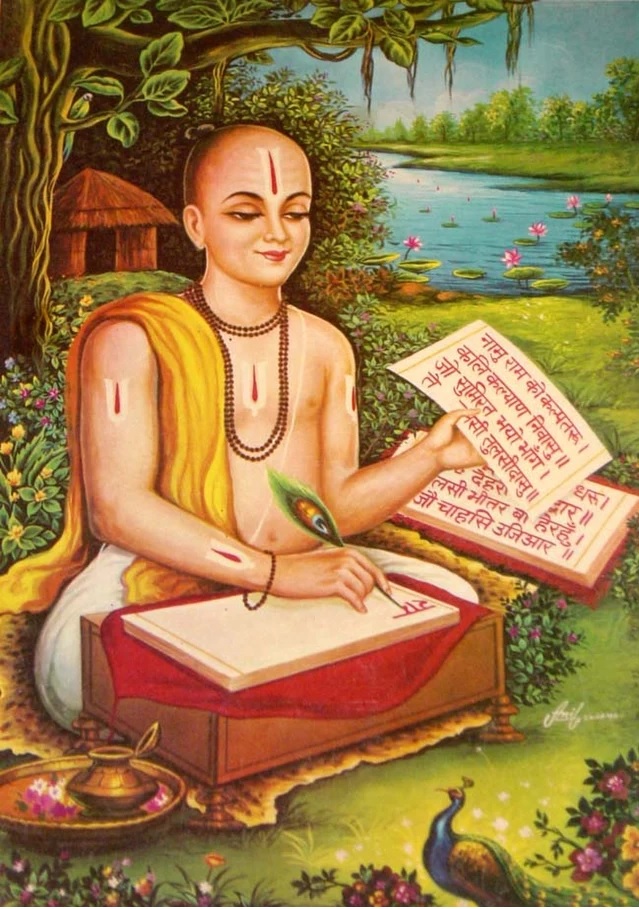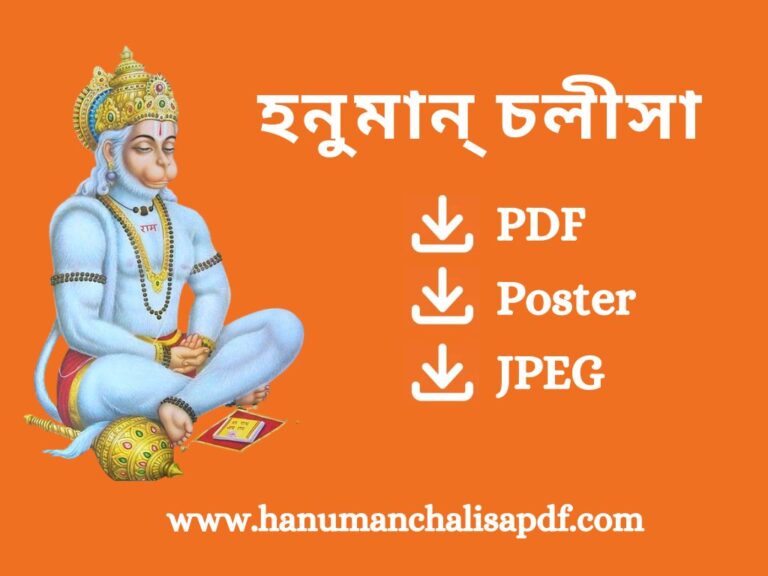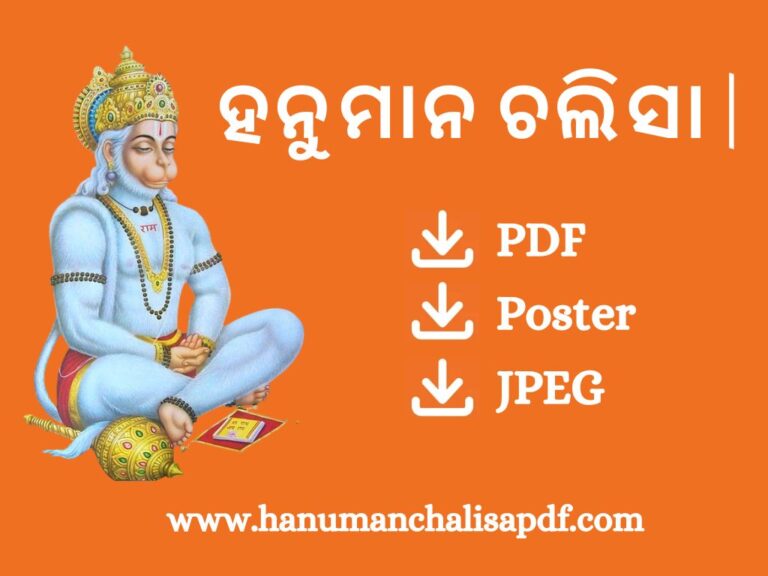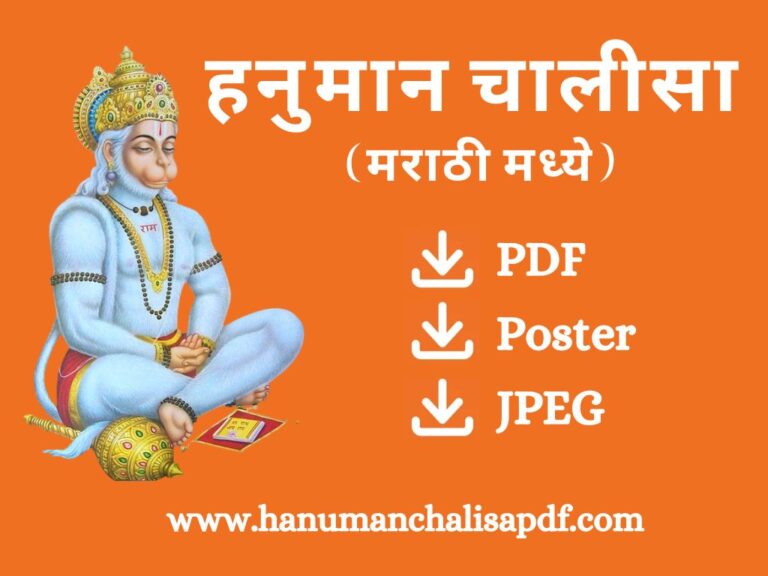Hanuman Chalisa: English PDF with Verse wise translation
Last Updated on March 11, 2023 by Admin
Shri Hanuman Chalisa PDF in English
Unlock the power of Lord Hanuman with the Hanuman Chalisa, an ancient Hindu devotional chant with our Hanuman Chalisa English PDF version
Our free English PDF download will help you to experience a deep spiritual connection with the beloved deity, reciting it in its original form and understanding the meaning behind the lyrics.
History of Hanuman Chalisa
The Hanuman Chalisa is a devotional hymn dedicated to Lord Hanuman, a Hindu god and an ardent devotee of Lord Rama. The poem was written by the 16th-century poet-saint, Tulsidas, who is also known for writing the Ramcharitmanas, a retelling of the Hindu epic Ramayana.
According to legend, Tulsidas was going through a difficult period in his life and was struggling to overcome his sorrows. He sought the blessings of Lord Hanuman, who appeared in his dream and instructed him to write the Hanuman Chalisa.
It is believed that by reciting the Hanuman Chalisa, one can overcome difficulties and attain devotion and blessings of Lord Hanuman.

The Hanuman Chalisa is written in Awadhi language, which is a dialect of Hindi spoken in the region of Awadh in present-day Uttar Pradesh, India. The poem is divided into 40 verses and is typically recited as a chant.
It is widely considered as one of the most powerful hymns in Hinduism, and is recited by millions of Hindus daily, especially on Tuesdays and Saturdays, which are considered auspicious days for worshiping Lord Hanuman.
The Hanuman Chalisa has been popularized in recent years through its frequent recitation in Hindu temples and household shrines, as well as through its inclusion in Bollywood films and other forms of popular culture.
It is also widely available in various languages (Punjabi, Odia, Bengali, Marathi, Tamil, Telugu, Kannada, etc.,) and is often recited by people of different regions and languages.
The Benefits and Power of Chanting Hanuman Chalisa
Chanting the Hanuman Chalisa has many spiritual benefits, like inspiring a sense of inner strength and courage, bestowing deep devotion to Lord Hanuman, and giving energy for fulfilling your goals.
With regular recitation of the Hanuman Chalisa, you are thought to be blessed with protection from harm and negativity, as well as spiritual awakening.
Chanting Hanuman Chalisa is believed to bring a variety of benefits to those who recite it regularly. Here are a few benefits that are commonly associated with chanting Hanuman Chalisa:
- Protection and blessings: Lord Hanuman is known as the protector and is believed to bestow blessings upon those who chant his hymn.
- Mental and emotional well-being: Chanting Hanuman Chalisa is believed to bring peace, calm and balance to the mind and emotions.
- Physical health: Regularly chanting Hanuman Chalisa is believed to improve overall physical health and remove negative energies.
- Increase in strength and power: Lord Hanuman is known as the embodiment of strength and power, it is believed that reciting his hymn can help one to increase in strength and power.
- Overcoming obstacles: Hanuman is known for his devotion and ability to overcome obstacles, reciting his hymn is believed to help one overcome obstacles in their own life.
How to Recite the Hanuman Chalisa: Learn the Meaning with a Free English PDF
Reciting Hanuman Chalisa is a Hindu devotional practice that is believed to bring blessings and protection from Lord Hanuman, who is considered a powerful deity in Hinduism. Here are some steps for reciting Hanuman Chalisa:
- Begin by lighting a lamp or a candle and placing it in front of a statue or picture of Lord Hanuman.
- Offer flowers or other offerings to Lord Hanuman, such as fruits, sweets, or incense.
- Sit in a comfortable position facing Lord Hanuman, and close your eyes. Take a few deep breaths and focus on your breath.
- Begin reciting the Hanuman Chalisa, which is a 40-verse hymn in praise of Lord Hanuman. It is traditionally recited in the Hindi language, but it can also be recited in other languages.
- Recite each verse with devotion, and try to understand the meaning of the words. Pronounce the words clearly and with proper emphasis.
- After reciting each verse, take a moment to reflect on its meaning and how it relates to your life.
- After reciting all 40 verses, offer a final prayer to Lord Hanuman, asking for his blessings and protection.
- End the recitation with “Sri Ram Jaya Ram Jaya Jaya Ram”
- It is good practice to recite Hanuman Chalisa on regular basis, many people recite it every morning and evening.
- It is also common to recite it 108 times.
Download our free English PDF for guidance on pronunciation and meaning so you can experience a deeper connection to this powerful mantra.
This post offers four options including Hanuman Chalisa English PDF
- Read Hanuman Chalisa in English
- Download Hanuman Chalisa English PDF
- Watch Hanuman Chalisa English Lyrics Video
- Download Hanuman Chalisa English MP3 download
Hanuman Chalisa Lyrics in English
The Hanuman Chalisa is divided into two parts, the “Chaupais” or four-line verses, and the “Doha” or couplets.
Doha
Shri Guru Charan Sarooja-Raj Nija Manu Mukura Sudhaari ।
Baranau Rahubhara Bimala Yasha Jo Dayaka Phala Chari ॥
Budhee-Heen Thanu Jannikay Sumirow Pavana Kumara ।
Bala-Budhee Vidya Dehoo Mohee Harahu Kalesha Vikaara ॥
Chaupai
Jai Hanuman gyan gun sagar ।
Jai kapis tihu lok ujagar ॥01॥
Ram doot atulit bal dhama ।
Anjaani-putra pavan sut nama ॥02॥
Mahabir bikram Bajrangi ।
Kumati nivar sumati ke sangi ॥03॥
Kanchan baran biraj subesa ।
Kanan kundal kunchit kesa ॥04॥
Hath bajra aur dhvaja biraje ।
Kaandhe munj janeu saje ॥05॥
Sankar suvan Kesari nandan ।
Tej pratap maha jag bandan ॥06॥
Bidyavaan guni ati chatur ।
Ram kaj karibe ko aatur ॥07॥
Prabhu charitra sunibe-ko rasiya ।
Ram Lakhan Sita maan basiya ॥08॥
Sukshma roop dhari Siyahi dikhava ।
Bikat roop dhari Lank jarava ॥09॥
Bhim roop dhari asur sahare ।
Ramachandra ke kaj savare ॥10॥
Laye sanjivan Lakhan jiyaye ।
Shri Raghuvir harashi ur laye ॥11॥
Raghupati kinhi bahut badhaee ।
Tum mam priye Bharat-hi-sam bhai ॥12॥
Sahas badan tumharo jas gaave ।
Asa-kahi Shripati kantha lagave ॥13॥
Sankadik brahmadi munisa ।
Narad-sarad sahit ahisa ॥14॥
Jum Kuber digpaal jaha teh ।
Kabi Kovid kahi sake kahan teh ॥15॥
Tum upkar Sugreevahi keenha ।
Ram milaye rajpad deenha ॥16॥
Tumharo mantra Vibhishan maana ।
Lankeshvar bhaye sab jag jana ॥17॥
Yug sahastra jojan par bhanu ।
Leelyo tahi madhur phaal janu ॥18॥
Prabhu mudrika meli mukh mahi ।
Jaladi langhi gaye achraj nahi ॥19॥
Durgaam kaj jagat ke jete ।
Sugam anugraha tumhre tete ॥20॥
Ram duwaare tum rakhvare ।
Hoat na adyna binu paisare ॥21॥
Sab sukh lahe tumhari sarna ।
Tum rakshak kahu ko darna ॥22॥
Aapan tej samharo aape ।
Teenho lok hank teh kanpe ॥23॥
Bhoot pisaach nikat nahin aave ।
Mahabir jab naam sunave ॥24॥
Nase rog hare sab peera ।
Japat nirantar Hanumant beera ॥25॥
Sankat se Hanuman chudave ।
Man karam bachan dyan jo lave ॥26॥
Sab par Ram tapasvee raja ।
Teen ke kaj sakal tum saja ॥27॥
Aur manorath jo koi lave ।
Sohi amit jeevan phal pave ॥28॥
Charo yug partap tumhara ।
Hai parasiddha jagat ujiyara ॥29॥
Sadhu sant ke tum rakhware ।
Asur nikanandan Ram dulare ॥30॥
Ashta-sidhi nav nidhi ke daata ।
Asabar deen Janki mata ॥31॥
Ram rasayan tumhare pasa ।
Sada raho Raghupati ke dasa ॥32॥
Tumhare bhajan Ram ko paave ।
Janam-janam ke dukh bisrave ॥33॥
Anth-kaal Raghubar pur jaee ।
Jaha janma Hari-bhakht kahaee ॥34॥
Aur devta chitta na dharaee ।
Hanumanth se he sarba sukh karaee ॥35॥
Sankat kate-mite sab peera ।
Jo sumire Hanumat balbeera ॥36॥
Jai Jai Jai Hanuman gosaee ।
Krupa karahu gurudev ki naee ॥37॥
Jo sath baar paath kar koi ।
Chuthee bandhi maha sukh hoee ॥38॥
Jo yaha padhe Hanuman Chalisa ।
Hoye Siddhi Sakhi Gaurisa ॥39॥
Tulsidas sada Hari chera ।
Keeje nath hridaye maha dera ॥40॥
Doha
Pavan tanay sankat harana mangal murti roop ।
Ram Lakhan Sita sahit hriday basau sur bhuup ॥
Hanuman Chalisa Translation in English
Doha
Shri Guru Charan Sarooja-Raj Nija Manu Mukura Sudhaari ।
Baranau Rahubhara Bimala Yasha Jo Dayaka Phala Chari ॥
Budhee-Heen Thanu Jannikay Sumirow Pavana Kumara ।
Bala-Budhee Vidya Dehoo Mohee Harahu Kalesha Vikaara ॥
This verse is praising Lord Hanuman and asking for blessings from the respected teacher. By purifying the mirror of my mind with the dust of the lotus feet of Shri Guru, I describe the qualities of Lord Shri Ram, who is the giver of all four types of fruits ( Dharma, Artha, Kaama and Moksha ).
Budhee-Heen (Ignorant) Thanu (Body) Jannikay (Creator) Sumirow (like Sun) Pavana (Pure) Kumara (Youth), Bala-Budhee (Strength and Knowledge) Vidya (Knowledge) Dehoo (body) Mohee (in me) Harahu (Remove) Kalesha (darkness) Vikaara (changes)”
O Pavan Kumar! Listen to me considering me as foolish and give me strength, wisdom, knowledge and take away my troubles and flaws.
Jai Hanuman gyan gun sagar ।
Jai kapis tihu lok ujagar ॥01॥
Ram doot atulit bal dhama ।
Anjaani-putra pavan sut nama ॥02॥
“Jai Hanuman (Victory to Hanuman), gyan gun sagar (ocean of knowledge and virtues), Jai kapis tihu lok ujagar (Victory to the messenger of Lord Rama, who awakens the three worlds), Ram doot (messenger of Lord Rama) atulit (unsurpassable) bal dhama (abode of strength), Anjaani-putra (son of Anjani) pavan sut (son of wind) nama (name)”
This verse is praising Lord Hanuman as the messenger of Lord Rama, who is the ocean of knowledge and virtues, who awakens the three worlds, who is unsurpassable in strength and the abode of strength. It also states that Lord Hanuman is the son of Anjani and the son of wind.
Mahabir bikram Bajrangi ।
Kumati nivar sumati ke sangi ॥03॥
Kanchan baran biraj subesa ।
Kanan kundal kunchit kesa ॥04॥
“Mahabir (great warrior), Bikram (brave), Bajrangi (name of Hanuman), Kumati (ill-tempered) nivar (remover), Sumati (good-tempered) ke sangi (in the company of), Kanchan (golden) baran (clothes), Biraj (splendid), Subesa (beautiful), Kanan (ear), Kundal (earring), Kunchit (adorned) kesa (hair)”
This verse is a further salutation to Lord Hanuman. It praises Hanuman as a great warrior, brave, and a powerful character known as Bajrangi. It also emphasizes on his ability to control his temper and his ability to change the temper of others. He is also praised for his physical beauty, his golden clothes and ornaments.
Hath bajra aur dhvaja biraje ।
Kaandhe munj janeu saje ॥05॥
Sankar suvan Kesari nandan ।
Tej pratap maha jag bandan ॥06॥
“Hath (hands) Bajra (thunderbolt), aur (and) Dhvaja (flag) biraje (holds), Kaandhe (on the shoulder) munj (sacred thread) janeu (wears), saje (holds), Sankar (Shiva) suvan (favored), Kesari (lion) nandan (son), Tej (power) pratap (splendor) maha (great) jag (world) bandan (servant)”
This verse is a further salutation to Lord Hanuman. It describes the physical appearance of Hanuman, mentioning that he holds a thunderbolt and flag in his hands and wears a sacred thread on his shoulder. He is also praised as being favored by Lord Shiva and as being the son of Kesari, a powerful character. He is also praised as the servant of the great world, who has great power and splendor.
Bidyavaan guni ati chatur ।
Ram kaj karibe ko aatur ॥07॥
Prabhu charitra sunibe-ko rasiya ।
Ram Lakhan Sita maan basiya ॥08॥
“Bidyavaan (learned), guni (virtuous), ati (very) chatur (clever), Ram kaj (work of Rama) karibe (will do) ko (any) aatur (eager), Prabhu (Lord) charitra (character) sunibe (will hear) ko (any) rasiya (devotee), Ram Lakhan Sita maan (respect) basiya (meditates)”
This verse is a further salutation to Lord Hanuman. It praises Hanuman as a learned, virtuous, and clever person who is always eager to do the work of Lord Rama. It also mentions that he will listen to any devotee’s story of Lord Rama and meditates on the respect of Lord Rama, Lakshman and Sita.
Sukshma roop dhari Siyahi dikhava ।
Bikat roop dhari Lank jarava ॥09॥
Bhim roop dhari asur sahare ।
Ramachandra ke kaj savare ॥10॥
“Sukshma (subtle) roop (form) dhari (takes), Siyahi (black ink) dikhava (shows), Bikat (terrifying) roop (form) dhari (takes), Lank (Lanka) jarava (burns), Bhim (terrifying) roop (form) dhari (takes), asur (demon) sahare (destroys), Ramachandra (Rama) ke (of) kaj (deeds) savare (does)”
This verse is a further salutation to Lord Hanuman. It describes Hanuman’s ability to take different forms, for example, in subtle form, he would show himself with black ink on his body. He also has the ability to take a terrifying form and burn Lanka, as well as destroy demons in a similar form. He is also praised for his deeds as a servant of Lord Rama.
Laye sanjivan Lakhan jiyaye ।
Shri Raghuvir harashi ur laye ॥11॥
Raghupati kinhi bahut badhaee ।
Tum mam priye Bharat-hi-sam bhai ॥12॥
“Laye (brings) sanjivan (life) Lakhan (Lakshman) jiyaye (revives), Shri Raghuvir (Rama) harashi (delighted) ur (makes) laye (brings), Raghupati (Rama) kinhi (something) bahut (very) badhaee (does), Tum (you) mam (me) priye (beloved) Bharat-hi-sam (along with Bharat) bhai (brother)”
This verse is a further salutation to Lord Hanuman. It describes Hanuman’s role in the Ramayana, where he brings life to Lakshman and make Rama delighted by bringing him back. He also praised for his deeds in serving Rama and also mentioned as a beloved brother of Bharat.
Sahas badan tumharo jas gaave ।
Asa-kahi Shripati kantha lagave ॥13॥
Sankadik brahmadi munisa ।
Narad-sarad sahit ahisa ॥14॥
“Sahas (thousands) badan (body) tumharo (your) jas (glory) gaave (sing), Asa-kahi (said) Shripati (Lord Rama) kantha (throat) lagave (embraced), Sankadik (all) brahmadi (Brahma) munisa (sages), Narad-sarad (Narada and Saraswati) sahit (with) ahisa (Ahi) (serpent)”
This verse is a further salutation to Lord Hanuman. It describes the glory of Hanuman and how everyone sings his praises, including Lord Rama himself. It also mentions how the sages including Brahma and the divine beings like Narada, Saraswati and Ahi serpent, embrace Hanuman’s glory.
Jum Kuber digpaal jaha teh ।
Kabi Kovid kahi sake kahan teh ॥15॥
Tum upkar Sugreevahi keenha ।
Ram milaye rajpad deenha ॥16॥
“Jum (Yama) Kuber (Kubera) digpaal (guardian of the quarters) jaha teh (wherever), Kabi (poet) Kovid (scholar) kahi (said) sake (is able to) kahan teh (wherever), Tum (you) upkar (favor) Sugreevahi (Sugreeva) keenha (did), Ram milaye (Ram met) rajpad (kingdom) deenha (gave)”
This verse is a further salutation to Lord Hanuman. It describes Hanuman’s ability to be everywhere and do anything, even in places where Yama and Kubera are the guardians. Also, he is praised for being a poet and a scholar, who can speak anywhere. He also praised for his favor on Sugreeva and his role in helping Rama to meet him and in giving back his kingdom.
Tumharo mantra Vibhishan maana ।
Lankeshvar bhaye sab jag jana ॥17॥
Yug sahastra jojan par bhanu ।
Leelyo tahi madhur phaal janu ॥18॥
“Tumharo (your) mantra (mantra) Vibhishan (Vibhishana) maana (accepts), Lankeshvar (King of Lanka) bhaye (fears) sab (all) jag (world) jana (people), Yug (age) sahastra (thousand) jojan (yojanas) par (on) bhanu (sun), Leelyo (plays) tahi (there) madhur (sweet) phaal (fruit) janu (know)”
This verse is a further salutation to Lord Hanuman. It describes Hanuman’s powers of persuasion, as even the king of Lanka, Vibhishana, accepted his mantra. He is also praised as someone who is feared by all people in the world. He is also praised as one who plays sweetly over a thousand yojanas away from the sun, and it is known that his deeds are sweet like fruits.
Prabhu mudrika meli mukh mahi ।
Jaladi langhi gaye achraj nahi ॥19॥
Durgaam kaj jagat ke jete ।
Sugam anugraha tumhre tete ॥20॥
“Prabhu (Lord) mudrika (ring) meli (held) mukh (face) mahi (on), Jaladi (water) langhi (crossed) gaye (gone) achraj (without any hesitation) nahi (not), Durgaam (difficult) kaj (work) jagat (world) ke (of) jete (do), Sugam (easy) anugraha (blessing) tumhre (your) tete (in)”
This verse is a further salutation to Lord Hanuman. It describes Hanuman as one who holds Lord Rama’s ring in his face, and also how he crossed the ocean without any hesitation. He is also praised as someone who can do difficult tasks in the world and he is praised for his blessings that are easily attainable.
Ram duwaare tum rakhvare ।
Hoat na adyna binu paisare ॥21॥
Sab sukh lahe tumhari sarna ।
Tum rakshak kahu ko darna ॥22॥
“Ram (Lord Rama) duwaare (gate) tum (you) rakhvare (keep), Hoat (anything) na (not) adyna (without) binu (any) paisare (fear), Sab (all) sukh (happiness) lahe (attain) tumhari (your) sarna (shelter), Tum (you) rakshak (protector) kahu (who) ko (any) darna (fear)”
This verse is a further salutation to Lord Hanuman. It describes Hanuman as the gatekeeper of Lord Rama, and that he does not fear anything. He is also praised for providing happiness to all those who take shelter under him and he is praised as the protector who does not fear anyone.
Aapan tej samharo aape ।
Teenho lok hank teh kanpe ॥23॥
Bhoot pisaach nikat nahin aave ।
Mahabir jab naam sunave ॥24॥
“Aapan (own) tej (power) samharo (control) aape (self), Teenho (three) lok (worlds) hank (shook) teh (then) kanpe (shaken), Bhoot (ghosts) pisaach (demons) nikat (near) nahin (not) aave (come), Mahabir (brave) jab (when) naam (name) sunave (hears)”
This verse is a further salutation to Lord Hanuman. It describes Hanuman’s ability to control his own power and how the three worlds shook when he exerted it. It also describes that ghosts and demons do not come near him when they hear his name, as he is known to be brave.
Nase rog hare sab peera ।
Japat nirantar Hanumant beera ॥25॥
Sankat se Hanuman chudave ।
Man karam bachan dyan jo lave ॥26॥
“Nase (nose) rog (disease) hare (cures) sab (all) peera (afflictions), Japat (recite) nirantar (continuously) Hanumant (Hanuman) beera (name), Sankat (difficulties) se (from) Hanuman (Hanuman) chudave (frees), Man (mind) karam (action) bachan (speech) dyan (meditation) jo (who) lave (takes)”
This verse is a further salutation to Lord Hanuman. It describes Hanuman as a powerful healer who can cure all diseases and afflictions, and it is said that by reciting his name continuously, one can free themselves from all difficulties. It also states that anyone who takes Hanuman’s name in their mind, action and speech and meditates on him will be freed from all difficulties.
Charo yug partap tumhara ।
Hai parasiddha jagat ujiyara ॥29॥
Sadhu sant ke tum rakhware ।
Asur nikanandan Ram dulare ॥30॥
“Charo (four) yug (ages) partap (splendor) tumhara (your), Hai (is) parasiddha (famous) jagat (world) ujiyara (illustrious), Sadhu (saints) sant (sage) ke (of) tum (you) rakhware (guardian), Asur (demon) nikanandan (killer) Ram (Lord Rama) dulare (beloved)”
This verse is a further salutation to Lord Hanuman. It describes Hanuman as one who is famous and illustrious in all four ages. It also mentions that Hanuman is the guardian of saints and sages and he is a destroyer of demons and beloved of Lord Rama.
Sab par Ram tapasvee raja ।
Teen ke kaj sakal tum saja ॥27॥
Aur manorath jo koi lave ।
Sohi amit jeevan phal pave ॥28॥
“Sab (all) par (on) Ram (Lord Rama) tapasvee (austere) raja (king), Teen (three) ke (of) kaj (work) sakal (all) tum (you) saja (accomplish), Aur (other) manorath (wish) jo (who) koi (anyone) lave (takes), Sohi (only) amit (unlimited) jeevan (life) phal (fruit) pave (gets)”
This verse is a further salutation to Lord Hanuman. It describes Hanuman as one who is able to accomplish all the tasks of Lord Rama, who is an austere king. It also mentions that any other wish that anyone might have will be fulfilled only if they take refuge in Hanuman, and they will get an unlimited life, the ultimate fruit.
Ashta-sidhi nav nidhi ke daata ।
Asabar deen Janki mata ॥31॥
Ram rasayan tumhare pasa ।
Sada raho Raghupati ke dasa ॥32॥
“Ashta-sidhi (eight kinds of) nav-nidhi (nine kinds of wealth) ke (of) daata (giver), Asabar (always) deen (the needy) Janki (Mother Janaki) mata (mother), Ram (Lord Rama) rasayan (elixir) tumhare (your) pasa (near), Sada (always) raho (remain) Raghupati (Lord Rama) ke (of) dasa (servant)”
This verse is a further salutation to Lord Hanuman. It describes Hanuman as the giver of eight kinds of spiritual powers and nine kinds of wealth, and it also states Mother Janaki has gifted Hanuman with the ability to bestow boons on deserving people. It also mentions that Lord Rama’s elixir is always near Hanuman and that Hanuman will always remain Lord Rama’s servant.
Tumhare bhajan Ram ko paave ।
Janam-janam ke dukh bisrave ॥33॥
Anth-kaal Raghubar pur jaee ।
Jaha janma Hari-bhakht kahaee ॥34॥
“Tumhare (your) bhajan (worship) Ram (Lord Rama) ko (to) paave (gets), Janam-janam (lifetimes) ke (of) dukh (sorrows) bisrave (removes), Anth-kaal (end of life) Raghubar (Lord Rama) pur (to) jaee (goes), Jaha (where) janma (birth) Hari-bhakht (devotee of Lord Vishnu) kahaee (is said)”
This verse is a further salutation to Lord Hanuman. It describes Hanuman as one who can lead to Lord Rama by his worship and removes sorrows of all the lifetimes. It also states that those who worship Hanuman will reach Lord Rama at the end of their life and will be born as a devotee of Lord Vishnu in their next life.
Aur devta chitta na dharaee ।
Hanumanth se he sarba sukh karaee ॥35॥
Sankat kate-mite sab peera ।
Jo sumire Hanumat balbeera ॥36॥
“Aur (other) devta (gods) chitta (mind) na (not) dharaee (holds), Hanumanth (Hanuman) se (with) he (he) sarba (all) sukh (happiness) karaee (gives), Sankat (difficulties) kate-mite (cuts off) sab (all) peera (perils), Jo (who) sumire (remembers) Hanumat (Hanuman) balbeera (strong)”
This verse is a further salutation to Lord Hanuman. It describes Hanuman as one who is so powerful that other gods are not able to hold his mind, and that by remembering Hanuman, he can provide all kinds of happiness. It also states that Hanuman can cut off all difficulties and perils.
Jai Jai Jai Hanuman gosaee ।
Krupa karahu gurudev ki naee ॥37॥
Jo sath baar paath kar koi ।
Chuthee bandhi maha sukh hoee ॥38॥
“Jai Jai Jai (Victory, Victory, Victory) Hanuman (Hanuman) gosaee (salutations), Krupa (grace) karahu (may give) gurudev (teacher) ki (of) naee (new), Jo (who) sath (hundred) baar (times) paath (recitation) kar (does) koi (anyone), Chuthee (bondage) bandhi (ties) maha (great) sukh (happiness) hoee (is)”
This verse is the final salutation to Lord Hanuman. It is asking for blessings of the teacher and by reciting the Hanuman Chalisa hundred times, one will be able to break free from all the bondages and attain great happiness.
Jo yaha padhe Hanuman Chalisa ।
Hoye Siddhi Sakhi Gaurisa ॥39॥
Tulsidas sada Hari chera ।
Keeje nath hridaye maha dera ॥40॥
“Jo (who) yaha (here) padhe (reads) Hanuman (Hanuman) Chalisa (poem of praise), Hoye (becomes) Siddhi (success) Sakhi (companion) Gaurisa (Gauranga), Tulsidas (the author) sada (always) Hari (Lord Vishnu) chera (servant), Keeje (does) nath (master) hridaye (in heart) maha (great) dera (abode)”
This verse is the final salutation to Lord Hanuman. It says that whoever reads the Hanuman Chalisa will become successful and a companion of Gauranga and that the author, Tulsidas, is always the servant of Lord Vishnu and has Lord Vishnu in his heart.
Doha
Pavan tanay sankat harana mangal murti roop ।
Ram Lakhan Sita sahit hriday basau sur bhuup ॥
This Doha is praising Lord Hanuman as the son of God of wind and an auspicious form who removes difficulties. He is also described as residing in the heart of Lord Rama, his brother and Lord Rama’s wife Sita, and is considered as one of the gods in their kingdom.
Rules for reciting Hanuman Chalisa
There are certain traditional rules and guidelines that are followed while reciting the Hanuman Chalisa. These include:
- Reciting the Hanuman Chalisa at least once a day is considered to be auspicious. Tuesdays and Saturdays are considered to be particularly auspicious days for reciting the Hanuman Chalisa.
- It is considered to be beneficial to recite the Hanuman Chalisa in the morning, after taking a bath and before starting one’s daily activities.
- Reciting the Hanuman Chalisa in front of a picture or statue of Lord Hanuman is considered to be more auspicious.
- The Hanuman Chalisa should be recited with devotion and concentration, focusing on the meaning of the verses and seeking Lord Hanuman’s blessings.
- It is traditional to offer a small offering of flowers, fruits, or sweets to Lord Hanuman before reciting the Hanuman Chalisa.
- Reciting the Hanuman Chalisa with other people in a group, such as in a temple or community setting, is considered to be more powerful.
- Hanuman Chalisa should be recited with respect and in a peaceful environment.
- It is recommended to recite Hanuman Chalisa with devotion and pure intention, to get blessings from Lord Hanuman.
Download Hanuman Chalisa English PDF
Hanuman Chalisa in English with Lyrics
Hanuman Chalisa English MP3 Download
Hanuman Chalisa by Lata Mangeshkar – Play Online
- Download Link – Hanuman Chalisa Gadhavi MP3
- Hanuman Chalisa – Lata Mangeshkar MP3
- Hanuman Chalisa – Udit Narayan MP3
Hanuman Mantra
A Hanuman mantra is a sacred phrase or invocation that is believed to invoke the blessings and protection of Lord Hanuman.
These mantras are commonly recited in Hindu devotional practices, such as puja (worship) and japa (repetition of a mantra) to seek the blessings of Lord Hanuman for protection, strength, wisdom, and success in various aspects of life.
Some of the popular Hanuman mantras include:
“Om Sri Hanumate Namaha”
“Om Sri Hanumate Namaha”
This mantra is a powerful chant that invokes the blessings and protection of Lord Hanuman, who is known for his devotion and strength. It is believed that by chanting this mantra regularly, one can overcome obstacles and negative influences in their life, and gain courage and determination to overcome any challenges.
Another popular Hanuman mantra is:
“Om Hanumate Rudratmakaya Hum Phat”
This mantra is believed to invoke the blessings and protection of Lord Hanuman, who is known for his strength and courage. It is said to help in removing obstacles and negative influences, and bring success and victory in all endeavors. It is also believed to help in acquiring knowledge, wisdom, and spiritual powers.
Another powerful Hanuman Mantra is:
“Om Anjaneyaya Vidmahe, Vayu Putraya Dhimahi, Tanno Hanuman Prachodayat”
This mantra invokes the blessings and guidance of Lord Hanuman, and is believed to help in gaining strength, courage, and wisdom to overcome obstacles and challenges in life. It is often recited to gain the blessings of Lord Hanuman and Lord Vayu (God of wind)
Keywords : hanuman chalisa english pdf one page, hanuman chalisa english subtitles, hanuman chalisa english meaning, hanuman chalisa english song, hanuman chalisa in english with meaning pdf, hanuman chalisa english word, hanuman chalisa written, hanuman aarti in english






